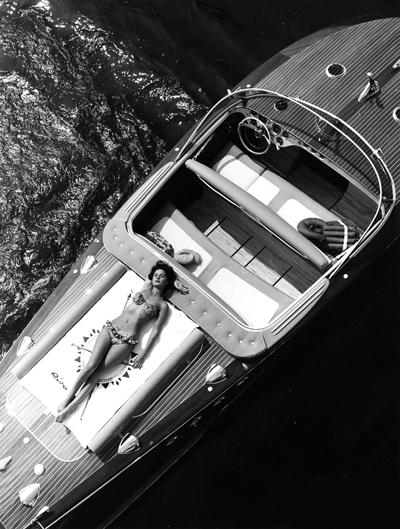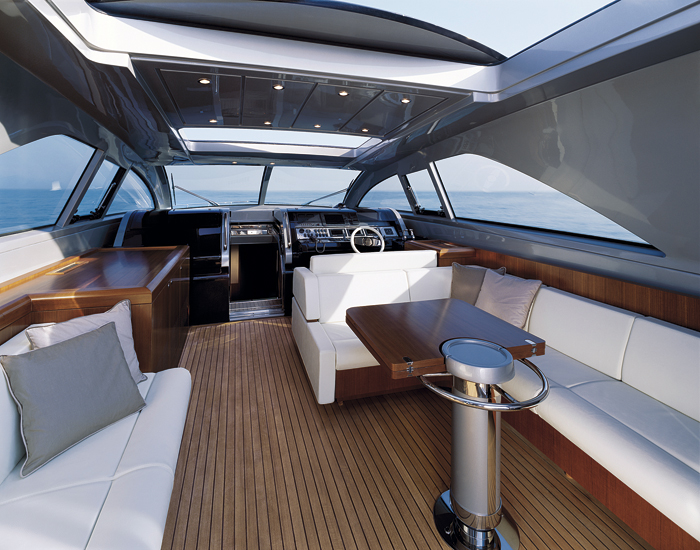Riva Boats
Legendary luxuryFew boat companies have a reputation like the brand of Riva. In the 1950s and 1960s its glamourous hand-built wooden boats made it famous. Today Riva is a big business, whose products range from elegant motor boats to luxury yachts.
It was 1842, when Pietro Riva, a young carpenter from Laglio on Lake Como, recently arrived in the port of Sarnico on Lake Iseo, stepped out one morning to look over the storm— battered boats of the distraught local fishermen, who felt they were lost for ever. It was a challenge that would have discouraged many. But like so many times before, the skilled Riva was up to it — and he repaired them all. Soon he was known along the lakeshore as the “miracle craftsman”.
With his talent Riva wanted to do more than just patch back together a few old barges — he wanted to build boats that no one had ever seen before. That’s exactly what he did — and so laid the foundation stone for the Riva yacht empire. In the 1880s Ernesto Riva, one of Pietro’s sons, took over the shipyard. Hewing firmly to the tradition of impeccable quality and craftsmanship, he nonetheless brought another dimension to his creations: he innovated.
Ernesto began to build piston engines in the boats, and he built the boats — this was new — to carry both passengers and cargo around the lake. But that true breakthrough led to the next innovation: under his leadership, the Riva shipyard entered the racing boat scene. And, as it turned out, to huge success. Its boats were the fastest and most powerful of their time. In 1912, Ernesto’s son Serafino hit the thensensational speed of 24 km/h in one of his beloved racing boats. Serafino’s ambition also carried Riva to several victories in national and international powerboat races between the world wars.
After the Second World War, his son Carlo, sensing a new wind, set out to build boats in series, after the American style. On borrowed money and in a rented shed, he also steered production away from the cheap speed boats to yachts that were purely for pleasure. He also began to put more money into advertising, which brought him into conflict with his father and with his father’s customers, who wanted the yard to stick to speedboats. It was a huge risk. But Carlo’s advertising, his designs, and his hard work — both in the shipyard and away from it, mingling with potential buyers at boat shows — paid off: by the 1950s the name of Riva was beginning to be the byword for quality, elegance, speed and status. Kings and emperors, princesses and sultans, actors and athletes, the international jet set and business magnates came to see the shipyard and take away the sleek Riva yachts. Brigitte Bardot, Richard Burton, Sean Connery, Peter Sellers, Sophia Loren, Prince Rainier of Monaco, King Hussein of Jordan, Aristotle Onassis and many others took them away — sometimes even by plane — and spread them around all the seas and fjords of the world, from Sweden to Australia. Even today, the rich and the famous are unable to resist the magnetic attraction of a Riva.
Riva today
In May 2000 Riva became part of the Ferretti Group — the world’s leading manufacturer of luxury motor yachts — and a new era began. Propelled by new momentum, Riva’s engineers and designers began to devise new models. Overseen by the unceasing creativity of Mauro Micheli and the design shop of Officina Italiana Design, in conjunction with the knowledge and experience of Norberto Ferretti, President of the Ferretti Group, there emerged a completely new Riva style — a style that set out to take the lead in yacht design and navigational performance.
While smaller boats such as the Aquariva and the Rivarama were manufactured in Sarnico, the new shipyard in La Spezia focused starting in November 2003 on yachts over 65 feet in length. Recently, two new models have entered production: Ego (68 feet) and Athena (115 feet), while the four brand-new models — Shuttle, Vertigo (both 63 feet), Venere (75 feet) and Opera Super (85 feet) hit the extremely challenging internationally market. Their success was — as befits the Riva name — legendary.
Masterpieces of design
Craftsmanship, peerless quality, and innovative yet resolutely traditional design have always been Riva’s seal of quality — and more so now than ever. With painstaking attention to the details of the build, every Riva yacht, from the 33-foot to the 115-foot model, gets its own, inimitable character, which is closely linked with its name. Riva yachts shine out not only through their outstanding performance: they are also elegant, timeless beauties on the water, bearing the spirit of the master carpenter Pietro Riva. Exclusive, unique design, clean lines and originality define a Riva today just as they did a hundred years ago.
The sleek curves of Riva yachts are dreamed up and sketched out by the inhouse design department: Officina Italiana Design. The boats have been taking their form from here for many years, where the details are brooded over and new benchmarks are set in motor yacht design.
Officina Italiana was founded in 1994 by Mauro Micheli and Sergio Beretta. The gifted artist and designer Micheli comes from Adrara San Martino, a peaceful village near the town of Bergamo, and studied at the Accademia di Belle Arti. Sergio Beretta, from Brescia, holds a degree in economics and is an avowed lover of contemporary art and design.
Micheli was 25 years old when he began his career at Riva in 1984 as Assistant Designer. The founding of Officina Italiana Design ten years later is the logical outcome of a fruitful collaboration with Riva, which has now lasted for twenty years. “Working for a yard like Riva,” says Micheli today, “every day is a challenge. That means keeping to the highest possible standards of quality in the work, both in the building and designing and in the material that goes into the Riva yachts. One also has to cope constantly with being confronted by the highest expectations, on the one part from the ever-shifting, intensely competitive market, and on the other hand from a traditionally sophisticated clientele.”
The acquisition of Riva by the Ferretti Group in May 2000 opened up a wealth of new perspectives for Officina Italiana Design, which despite being with the shipyard for only twenty years is already a key part of its history. It’s no surprise, then, that the design shop has drafted all the models that are currently in production: from the 33-foot-long Aquariva, heir to the Aquarama, the legendary runabout of the Sixties, to the 115-foot-long Athena, the Riva fleet’s flagship; from the Rivarama, a 44-foot yacht that has won “Best European Open” twice in the 40-50-foot class, to the Rivale, a 52-foot yacht, one of the most successful yachts in the world.
Things are never dull for the designers of Officina Italiana Design. With Riva, the Design Studio, which currently works with four other young talents (Alberto Stella, Filippo Salvetti, Marco Biaggi and Daria Giovenzana), wakes up each day to new adventures and challenges. “At Officina Italiana”, Micheli explains, “we don’t want ‘loud and showy’ boats, which stand out only for their formal virtuosity. We prefer clear, strong, classic lines. The magic word here is ‘take away’, not ‘add’. Our goal is to create a unique and unmistakeable style, where innovation harmoniously combines with the traditional design — and becomes a legend.”
 The international Art Magazine
The international Art Magazine
